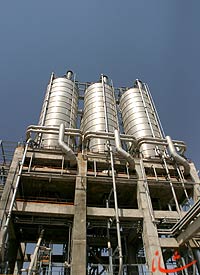Methanol, ethylene, propylene, butadiene, dichloride ethylene, LAB, and PTA constitute the main basic products the country exports to foreign countries.
Propane, butane, pyrolyse gasoline, pentane plus, and heavy slice are the export-bound by-products and fuels while benzene, paraxylene, and heavy slice of aromatic are the main aromatic products
Ammoniac, ammonium nitrate, sulfur, and sulfuric acid are categorized in the fertilizer products and light and heavy polyethylene products, melamine crystal, PVC, and PET are the polymeric products that the country is considering exporting.
Japan, the United Arab Emirates (UAE), China , India , South Korea , Italy ,
These countries accounted for 86 and 80 percent of Iran"s export-bound petrochemicals in terms of weight and value respectively.
Of about five million tons of petrochemical products
BREAKTHROUGH
Iranian experts had achieved technical know-how for gas-phase polymerization, head of Arak Petrochemical Research and Technology Center announced.
Gholamhossein Varshouy told IRNA Sunday that the center attained the success after its specialists managed to launch a gas-phase polymerization process (GPPP) unit.
He recalled that German designer in charge of launching the unit had earlier refused to continue cooperation with Iran , expressing doubt that Iranians would be able to set up the unit.
The unit was completely launched by using indigenous knowledge with the support of Petrochemical Research and Technology Company.
Varshouy added that the achievement would help cut expenses by producing ultrahigh molecular weight polyethylene (UHMWPE).
UHMWPE is synthesized from monomers of ethylene, which are bonded together to form what is called ultrahigh molecular weight polyethylene.
UHMWPE fibers are used in bulletproof vests, bow strings, climbing equipment, fishing line, spearguns, high performance sails, suspension lines on sport parachutes, rigging in yachting, and kites and kites lines for kite sports.
He said that gas-phase polymerization process would also help the country produce ethylene copolymers, propylene, ethylene polymer, and other products.
Experts set up the unit in six months while it was estimated that its launch would take two years, he added.
The official said that the success would open a new chapter in the country"s petrochemical sector.
This method is used with gaseous monomers such as ethylene, tetrafluoroethylene, and vinyl chloride. The monomer is introduced under pressure into a reaction vessel containing a polymerization initiator. Once polymerization begins, monomer molecules diffuse to the growing polymer chains. The resulting polymer is obtained as a granular solid.
OUTPUT INCREASE
Iran?s Fifth Five-Year Socioeconomic Development Plan (2010-2015) has planned for increasing the annual petrochemical production from 55 million tons to 158 million tons.
According to the initial estimate, domestic petrochemical output will witness a 33.7 million ton increase during the period.
Based on the plan, 27 projects will become operational through investing 12.325 billion dollars by 2015.
Petrochemical products accounted for the highest share of non-oil goods Iran exported in the past Iranian calendar year (March 21, 2006 to March 20, 2007).
Totally 42.2 percent of the weight and 38.6 percent of the value of exported non-oil products belonged to petrochemicals.
The country exported 14,236,800 tons of petrochemical products, valued at 6.11 billion dollars, during the yearlong period, showing 115.5 and 140.8 percent increases in terms of weight and worth respectively when compared to those in their preceding year.
The country has produced 3.141 million tons of different types of petrochemical products from March 21 to May 21, 2007.
Iran will turn out to be a large producer of aromatic, ethylene, and methanol products by the end of Iranian calendar year of 1393 (March 20, 2015), according to predictions.
On July 2, Borzouyeh Petrochemical Complex, the world"s largest aromatic project, was inaugurated in the presence of Iranian President Mahmoud Ahamdinejad and his Venezuelan counterpart Hugo Chavez in Assalouyeh in southern Iran .
The complex is to yield 1.28 million tons of main products including paraxylene, orthoxylene, and benzene as well as 3.178 million tons of byproducts such as light and heavy hydrocarbons, slice of pentane, raffinate, and liquefied gas per annum.
The products are used as raw material for production of polyesters, synthetic fibers, paints, resins, disposable bottles, pharmaceutical compounds, and pesticides.
The other two acetic acid complexes of Fanavaran and Ghadir would be also inaugurated by June 21, announced
Ahmadinejad agreed to change the name of "Borzouyeh" to "Nouri" Petrochemical Complex.
The decision was made following the request of the family of Mohammad Nouri, former managing director of the complex, who died last year.


Your Comment